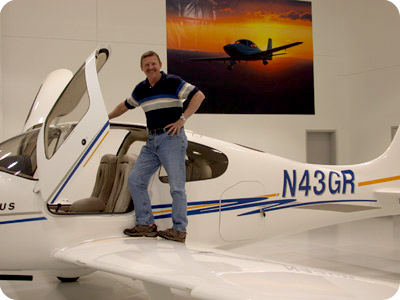|
|
January Fly-Bys
Autopilot Advice: An Interview With Gil Rud
Courtesy of Gil Rud,
Director of Business Development, Boeing
Patuxent
River, Maryland
 Pilots are used to getting advice from other pilots.
Sometimes they pay attention, sometimes they don’t. However,
when that advice comes from a pilot with Gil Rud’s credentials,
it would be wise to listen. With a distinguished history including
5600 hours as a Naval Aviator, Gil has had experiences that many
of us can only dream of. He is also in a unique position to track
the advancements of cockpit automation thanks to his distinguished
career path. Pilots are used to getting advice from other pilots.
Sometimes they pay attention, sometimes they don’t. However,
when that advice comes from a pilot with Gil Rud’s credentials,
it would be wise to listen. With a distinguished history including
5600 hours as a Naval Aviator, Gil has had experiences that many
of us can only dream of. He is also in a unique position to track
the advancements of cockpit automation thanks to his distinguished
career path.
Gil’s first military assignment was in A4 Skyhawks.
From there, he moved into A7B and A7E Corsair IIs, with many hours
earned in
wartime and in command of the 192nd Golden Dragons Attack Squadron.
In 1986, he was chosen to lead the Navy’s Blue Angels demonstration
team and led them through the transition from the A4 Skyhawk into
the F-18 Hornet. Most recently, Gil rejoined his fellow pilots and
became a Cirrus owner.
“In the A4 there was little to no pilot assist
mode for the flight controls. The A7 had improved capabilities, but
the Hornet had the
ability to make a hands-off landing on an aircraft carrier,” said
Rud. Being a part of automation evolution allowed Gil to see first-hand
the value and importance of proper autopilot use. “During
long repositioning flights in the Hornet, the autopilot really
helped
reduce fatigue.” Additionally, the autopilot was a valuable
tool that reduced workload and increased situational awareness
as Gil and his wingmen flew F-18s at more than 8 miles per minute.
Gil’s
appreciation of the autopilot has extended to flights in his Cirrus
SR20. He often uses its capabilities to maintain situational
awareness and simplify his flight tasks. To help you safely and
efficiently operate your autopilot, Gil offered the following tips:
- Practice,
knowledge, and proper use are key.
“
The autopilot will only help if you understand it, utilize it, and
are proficient,” states Rud. While it may seem obvious, many
pilots don’t think of using their autopilots until they
need them. Unfortunately, situations where they are needed are
not the
most convenient situations to learn how to use them.
- The pilot
is always the ultimate authority during the flight.
Many pilots turn on the autopilot and lose track of where they
are and what the plane is doing. Remember that the autopilot
is not a
substitute for diligence in the airplane. “You should always
be the PIC. The autopilot is a co-pilot at best,” says
Gil. “Keep
the human factor in there at all times.”
- Take advantage
of the autopilot in IMC.
“
Single pilot, you have your hands full, especially in the weather,” says
Gil. Workload can be highest during departure, arrival, and approach
while operating in the IFR system and the autopilot can help
significantly reduce pilot demand. Gil specifically suggests
using the autopilot
during complex route changes, avionics tasks, and checklist procedures.
- The autopilot can help you even in VMC.
“Be very careful about keeping your head in the cockpit on a VFR
day,” advises
Rud. When the skies are blue and the sun is shining, there are
probably a lot of pilots in the air and a diligent traffic scan
will go a
long way toward keeping you safe. Using the autopilot may reduce
your workload, allowing you to spend more time looking outside.”
- Know the autopilot limitations.
Like most things in aviation, autopilots have defined limits
and it’s important for pilots to know them. Gil has seen controllers
give vectors that were too close to the FAF for the approach mode
to capture the localizer and crosswinds that were beyond the capabilities
of the autopilot system. In both cases, he recognized that the limits
were exceeded and flew the airplane manually to prevent unexpected
responses. “Know the limits ahead of time so that you don’t
panic when they’re passed,” he suggests. One of Gil’s
favorite tricks is to use the PFD wind vector to monitor
the crosswind component during an approach, confirming that
the limitations have
not been exceeded.
- Know your own abilities and comfort zone.
Even with his experience in varied conditions and a wide range
of airplanes, Gil emphasizes the importance of knowing your
boundaries: “Pay
attention to your personal limits. Even with the autopilot, I’m
just getting comfortable shooting approaches to minimums after
7 months and 215 hours in my plane.”
- A little instruction
goes a long way.
Perhaps because of his incredible experience as a pilot, Gil
recognized that he needed instruction to fully utilize the capability
of his
autopilot. As a novice S-Tec 55SR user, he flew both VFR and simulated
IFR approaches with a flight instructor who was already familiar
with his autopilot system. Now that he is comfortable and proficient
in its use, he still flies occasionally with a CFI-I in the right
seat. “I make sure that I can always meet the requirements
of an IPC or BFR,” Gil said. No matter what, he reminds pilots
that it’s important to “put aside your pride and be
a student again.”
Back to top |
|


